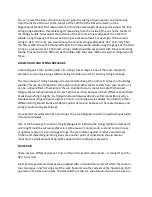
You can preset the basic intonation of your guitar by taking a tape measure and measuring
from the inside of the nut to the center of the 12th fret (the fret wire itself; not the
fingerboard). Double that measurement to find the scale length of your guitar. Adjust the first-
string bridge saddle to this scale length, measuring from the inside of the nut to the center of
the bridge saddle. Now adjust the distance of the second-string saddle back from the first
saddle, using the gauge of the second string as a measurement. For example, If the second
string is .011" (0.3 mm), you would move the second-string saddle back .011" (0.3 mm) from
the first saddle. Move the third saddle back from the second saddle using the gauge of the third
string as a measurement. The fourth-string saddle should be set parallel with the second-string
saddle. Proceed with the fifth and sixth saddles with the same method used for strings two and
three.
LUBRICATION AND STRING BREAKAGE
Lubricating all of the contact points of a string's travel may be one of the most important
elements in ensuring tuning stability during tremolo use and in reducing string breakage.
The main cause of string breakage is moisture collection at the point of contact on the bridge
saddle. This can be attributed to the moisture and acidity that transfers from your hands, or it
can be a direct effect of humidity in the air. Another factor is metal-to-metal friction and
fatigue. Metal components react to each other over time because of their differences and help
break down string integrity. A stronger metal will always attack a softer metal (this is why a
stainless-steel string will wear a groove or burr in a vintage-style saddle). You'll also find that
different string brands break at different points of tension because of the metal makeup and
string manufacturing techniques.
Since Fender manufactures its own strings, they are designed to perform well during extreme
tremolo techniques.
One of the best ways to reduce string breakage is to lubricate the string/saddle contact point
with a light machine oil (we prefer 3-in-1 oil because it contains anti-rust and anti-corrosive
properties) every time you change strings. The oil insulates against moisture and reduces
friction and metal fatigue. String trees are another point of contact and should also be
lubricated; a small amount of lip balm applied with a toothpick works well.
TRUSS ROD
There are two different styles of truss rod found on Fender instruments—"standard" and "bi-
flex" truss rods.
Most Fender guitars and basses are equipped with a standard truss rod (of which there are in
turn two types: one that adjusts at the neck heel and one that adjusts at the headstock; both
operate on the same principle). The standard truss rod can counteract concave curvature in a



























